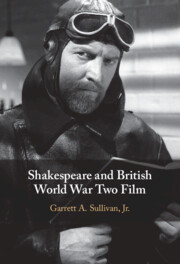Book contents
- Shakespeare and British World War Two Film
- Shakespeare and British World War Two Film
- Copyright page
- Dedication
- Contents
- Figures
- Acknowledgments
- Introduction
- Chapter 1 “Hamlet’s a Loser, Leslie”
- Chapter 2 “What We All Have in Common”
- Chapter 3 The Black-White Gentleman
- Chapter 4 “Bottom’s Not a Gangster!”
- Coda Two Cities Films and “the Spirit of Britain”
- Index
Chapter 2 - “What We All Have in Common”
Fires Were Started, Macbeth and the People’s War
Published online by Cambridge University Press: 24 March 2022
- Shakespeare and British World War Two Film
- Shakespeare and British World War Two Film
- Copyright page
- Dedication
- Contents
- Figures
- Acknowledgments
- Introduction
- Chapter 1 “Hamlet’s a Loser, Leslie”
- Chapter 2 “What We All Have in Common”
- Chapter 3 The Black-White Gentleman
- Chapter 4 “Bottom’s Not a Gangster!”
- Coda Two Cities Films and “the Spirit of Britain”
- Index
Summary
The great documentarian Humphrey Jennings is credited with helping to create the iconography of “the people’s war,” a period concept that emphasized how people of all social positions pulled together for the collective good. In Fires Were Started, which focuses on a day in the life of an Auxiliary Fire Service substation, a weary and grief-stricken fireman reads aloud from Macbeth’s speech to Banquo’s murderers. Whereas these lines have (somewhat bizarrely) been taken as evidence of Shakespeare’s status as an emblem of national unity, they articulate a strong sense of class grievance as well as skepticism about the collective ideal of the “people’s war.” In this way, Jennings mobilizes Shakespeare to explore the limits of the model of unity with which the playwright was associated. In doing so, Jennings contends that such unity is not given but in constant need of re-attainment.
Keywords
- Type
- Chapter
- Information
- Shakespeare and British World War Two Film , pp. 58 - 95Publisher: Cambridge University PressPrint publication year: 2022

